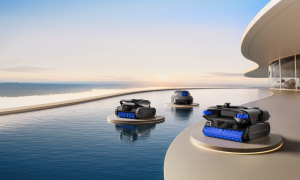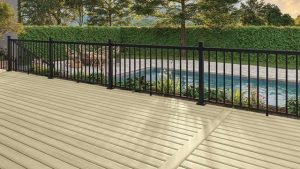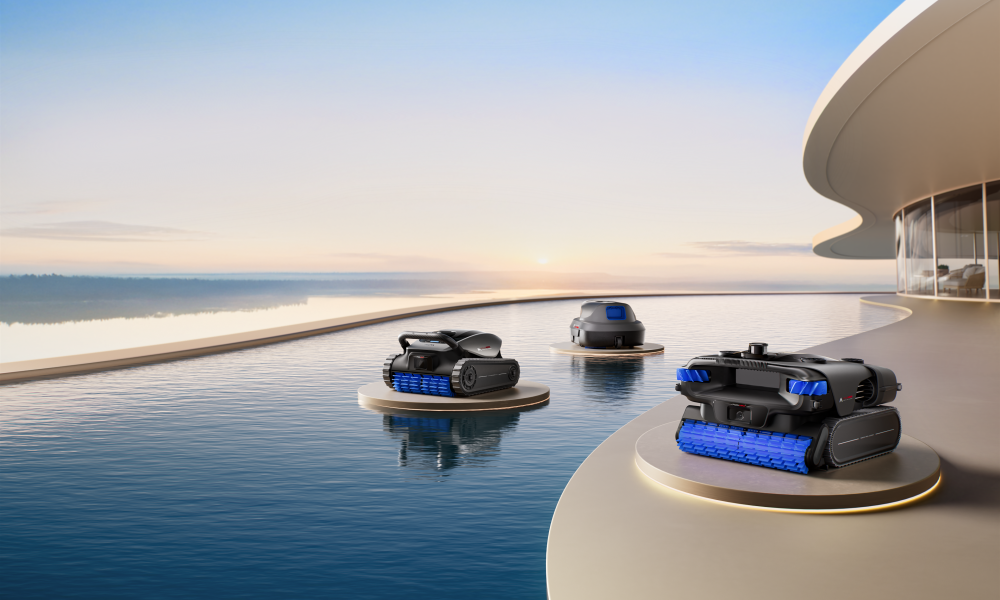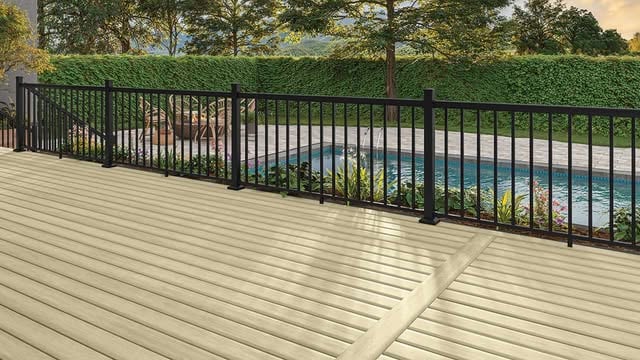Picture this: it’s a blazing summer afternoon in Florida. A pool tech is kneeling beside a filter tank, sweat dripping, hands coated in grit and cartridge lube. The homeowner stands nearby, watching every move, ready to pounce with questions about why their water isn’t sparkling yet. The job should take 20 minutes, but with a stubborn O-ring and a cartridge design that makes reassembly clunky, it drags into 45. The tech’s thought in that moment is simple — there’s got to be a better way.
That thought, echoed thousands of times across backyards, is shaping the future of the pool and spa industry.
FIELD FRUSTRATION = OPPORTUNITY
At The Grit Game, we live at a rare intersection: on one side, service pros who spend their days solving problems in the field; on the other, product developers eager to create the next must-have innovation. What we hear from techs is consistent — and it goes beyond “this product works” or “that one doesn’t.” It’s a wish list grounded in reality.
Techs want products that:
- Save time and simplify installs
- Hold up under tough, real-world conditions
- Reduce physical strain and human error
- Protect their credibility
In short, they want tools built for the backyard, not just the showroom floor. And manufacturers who understand these service-side desires are taking the first step toward creating products that truly move the industry forward.
COMMON COMPLAINTS AND PAIN POINTS
Ask service pros what they wish product designers understood, and the answers don’t circle around theory — they cut straight to the grind of everyday work.
“I wish product designers understood what it’s like to lug all the crap to the backyard. Ever tried lugging a hammer head cart off the truck up the driveway, through the gate, over patio stones, all while balancing a jug or two, test kit, hose, pole? And I wish they understood how hard the guys are on the equipment. It’s flung into the bed of the truck, dropped on the pool deck, then half-assed stuffed back into a case, a 5-gallon bucket, the tote on the cart and then back into the bed of the truck.”
—Jeremy Hine | 20-Year Pool Pro | Florida Leisure Pool & Spa | Gainesville, Fla.
Durability is a constant recurring theme.
“We need everything light yet durable.”
—Nicolas Collier | Sacred Pool Service | San Diego, Calif.
“The more ‘portable’ the better. The fewer steps the better.”
—Don Douglas | RevdUp Pool Service | Land O Lakes, Fla.
Which connects directly to the way Eric Wall, director of training here at The Grit Game sees it: “When a feature speaks directly to a tech’s pain points, you can feel the shift. Techs respect innovation that removes steps, not adds them. A pump that self-primes, or a heater that auto- diagnoses problems, feels like a real advancement and not just a gimmick.”
Sometimes, the frustration comes from constantly repairing gear that just wasn’t built with service realities in mind.
“Manufacturers would be surprised by how much effort goes into keeping the thing running. Whatever it is — a wheelbarrow that needs to be rebuilt (yes, a wheelbarrow). The skim nets. I repair these multiple times before rendering them to the dumpster out back. The repair is stronger than the mesh itself. Just have to catch the small holes before they become huge holes. My point of view is that I’m always stuck with fixing the broken [stuff ] made by, built by, installed by someone who isn’t the one to be here later to deal with it.”
—Jeremy Hine
Others, like Joshua Frost of Redbird Pool Service, Bloomington, Ill., focus on the smaller details that make or break a service call:
“Small details can make a huge difference in the field. Things like tool-free access panels, clear labeling on wiring and plumbing connections, and diagnostic readouts you can see without disassembling half the equipment pad save a ton of time. Even something as simple as corrosion- resistant screws, weather-sealed control panels, or quick-connect fittings can turn a 45-minute repair into a 10-minute one.
For me, the biggest game changers are features that anticipate service needs — built-in pressure gauges, error-code history, or a way to reset and recalibrate equipment without diving deep into a hidden menu. Those little touches add up to fewer mistakes, faster service calls, and happier customers.”
Or, as Eric Wall puts it: “Awkward access panels, cramped spaces, or unserviceable parts make techs feel the product designer just didn’t think about them.”
Put together, these stories reveal the same underlying message: Techs aren’t asking for luxury, they’re begging for practicality. Light, portable, durable products. Equipment that respects the reality of rough handling and sometimes rougher conditions. And thoughtful designs that make their lives faster, easier, and less frustrating in the field.
PRODUCT CATEGORIES AND TRENDS WHERE PERFORMANCE WINS
Innovation in certain categories is beginning to hit the mark, delivering the kind of performance that saves time and builds confidence in the field.
At The Grit Game, William Brist, national technical sales manager, sees it clearly: “Anything that makes the job quicker, easier without sacrificing durability. Pool lights with removable cables, unions, tech apps for automation set up, etc. Automation and robotics are getting more attention now than ever because they just perform better than they used to.”
That observation is echoed directly from the field when we asked what product categories seem to be getting more advanced lately :
- “Robot cleaners.”
—RevdUp Pool Service | Land O Lakes, Fla. - “Robotic vacuums.”
—Rob Marhews | Pristine Water | Williston, Fla. - “Battery-powered suction tools.”
—Sacred Pool Service | San Diego, Calif. - “Robotic battery-powered pool cleaners.”
—Luke Pool Service | Cumming, Ga.
We’re seeing a pattern.
Chris Frising, northeast rep at The Grit Game, explains how smarter, service-focused design makes a difference: “Service techs are definitely shifting toward smarter and simpler tools that streamline their work and cut down on mistakes. Digital water testing, wireless autofill systems, and app-connected controls are great examples — these tools reduce guesswork, speed up routine tasks, and provide reliable data techs can trust. The trend is clear: If a tool or product can make the service process faster, more accurate, and less frustrating, techs will adopt it quickly and build their brand loyalty around it.”
On the ground, Joshua Frost of Redbird Pool Service, Bloomington, Ill., has seen the same shift firsthand:
“Automation and remote monitoring have made some of the biggest leaps lately. Smart pumps, heaters, and automated water chemistry systems have gotten far more intuitive, with app- based controls that allow both the homeowner and the service tech to see what’s happening in real time.
The best products are those that combine durability with actionable data — equipment that doesn’t just run, but actively tells you what’s going on and why. That’s where the industry is headed, and it’s making life easier for techs and pool owners alike.”
If you connect the dots, techs aren’t just looking for better-built tools — they’re gravitating toward systems that anticipate problems, guide decisions, and stay out of the way. The ultimate win is a product that requires almost no babysitting: intuitive, low- maintenance, and reliable enough to feel like a ‘set-it-and-forget-it’ solution.
CASE STUDY: JOSHUA FROST, REDBIRD POOL SERVICE
With 120 pools on his weekly route, Joshua Frost of Redbird Pool Service in Bloomington, Ill., qualifies as a high-volume service technician. His perspective offers a clear case study in what frontline professionals value in products — and why certain innovations earn trust while others fade with the season.
1. CORE CRITERIA FOR SELECTING TOOLS AND PARTS
Frost evaluates every product against three non-negotiables:
- Reliability: “It’s built to handle real-world abuse — heat, cold, rain, chemical exposure — without constant babysitting.”
- Serviceability: “I can swap a part or make a repair quickly without needing a proprietary tool kit or a half-day teardown.”
- Data: “It tells me what’s going on, either through on-board diagnostics or remote monitoring, so I can make informed decisions before I even open the equipment pad.”
He adds that even the best products fail without solid backing: “A great product with poor tech support or no available parts becomes a headache in the long run. If I can trust the tool or part to work under tough conditions, fix it fast when it doesn’t, and get accurate information from it, I’ll feel confident putting it into service.”
2. WHY TECHS RECOMMEND PRODUCTS TO EACH OTHER
For Frost, peer recommendations hinge on consistency: “When a fellow tech recommends a product, it’s almost always because it reduces headaches — either in the install or
in the long-term maintenance. That usually boils down to reliability and fewer callbacks. In the field, speed is great, but if you have to come back two or three times to fix the same issue, you’ve lost any time you saved.
I only recommend a product if I’ve seen it prove itself in real-world conditions, not just in a brochure. That means it’s reliable, easy to service, performs consistently across different pools, and has strong manufacturer support.”
Ease of installation matters, especially for high-volume routes, but what drives long-term adoption is equipment that performs season after season in real-world conditions.
3. NOT SEEN FROM THE LAB
Among all Frost’s observations, perhaps the most telling is how far lab conditions diverge from the realities of the field: “If a manufacturer shadowed me for a day, I think they’d be surprised by how much of my job is problem-solving in less-than-ideal conditions. In a lab
or showroom, everything is installed perfectly, the water is balanced, and there’s no rush. In the field, you might be working in 95-degree heat or freezing wind, with equipment that hasn’t been maintained in years, and still be expected to have it running flawlessly within the hour.
“They’d probably also be surprised at how much time is spent on diagnosis versus actual repair. The right tools and clear diagnostics can cut that time in half, but when you’re dealing with older systems, poor installation, or vague error codes, it can feel like detective work.” Frost’s perspective as a high-volume tech perfectly illustrates what our team at The Grit Game hears every day. His call for reliability, serviceability, data, and strong support isn’t a lone opinion — it’s a chorus echoed to reps loud and clear.
“They want less problems. Too many ‘innovations’ make the job harder. Techs want fewer callbacks and easier repairs.”
—Jared Medeiros | Florida
- “The techs in the industry are looking for products that are designed to have serviceability.”
— Ryan Walker | Midwest - “Support. Support. Support. They can never get enough.”
—Kip Sanders | Florida
BRIDGING THE GAP BETWEEN THE FIELD AND THE FACTORY
For manufacturers, the alignment between techs and reps is critical. When both groups are saying the same thing, these aren’t just preferences — they’re requirements. And this is exactly where rep firms like The Grit Game add value: connecting the daily realities of service pros with the innovation pipelines of product manufacturers.
As Lori Pierce, Florida rep, explains:
“We get to be the eyes and ears for our manufacturers — communicating daily with the pros who use the products. In turn, that gives us the voice for their customers in order to assist with pros/cons and future improvements. I see reps as a win- win for both sides.”
Eric Wall, director of training, emphasizes the translation role reps play between manufactures and techs:
“We bridge the language gap between manufacturers and the field. Field professionals may describe issues in practical terms (‘it clogs,’ ‘too heavy,’ ‘takes too long’), while product engineers think in specs and tolerances. Reps translate between the two worlds — making sure the field is heard and R&D understands what the problem really is.”
ONE PIECE OF ADVICE
So what would reps tell manufacturers, if they had to give just one piece of advice when it comes to products used by service techs?
Chris Frising, Delaware: “Design with the service tech in mind from the very beginning. That means thinking about how easily a product can be installed, maintained, and repaired in real-world conditions — not just how it looks on paper or in a showroom. Simple touches like tool-free access, standardized parts, clear labeling, and straightforward troubleshooting guides can save hours in the field. When products are intuitive and service-friendly, techs are more likely to recommend and stick with that brand, creating long-term loyalty and trust. Manufacturers that actively seek feedback from service professionals during the design and testing phase tend to produce solutions that perform better across the entire lifecycle of the product.”
TJ Walker, New Jersey: “Make access to the serviceable parts as easy as possible without having to dismantle them.”
Craig Mosch, New York: “Design for faster, easier installation. Provide clearer instructions and training resources. Offer better technical support and responsiveness. Simplify technology and avoid unnecessary complexity. Respect and incorporate technician feedback in product design.”
WHY FEEDBACK MATTERS
The strongest reminder came from Gary Thomas, vice president of sales at The Grit Game:
“I have passed feedback to a manufacturer that led to a product improvement on several occasions. The biggest thing is understanding a manufacturer’s position. It is difficult to change/ improve something for a limited number of people. You have to be able to explain how the change will resonate across multiple regions.”
From the Midwest, Michael Thill highlighted how reps turn those individual concerns into a collective voice:
“Our opportunity as reps to meet with our dealers with regularity and build strong relationships simply lead to conversations that reveal friction points that the dealers experience when in the field. One dealer may not feel that their voices are heard when talking to manufacturers. But when a rep hears from multiple dealers and is able to pass along the information to the manufacturer, it becomes the loudest voice in the room and makes the manufacturers take notice.”
And that’s the point: Feedback doesn’t just disappear into the field. When techs share their experiences with reps, those insights don’t stay local — they get amplified. A single frustration may feel small, but when reps hear the same story from dozens of pros across different regions, it becomes impossible for manufacturers to ignore. That’s the kind of weight that sparks change.
Which is why it’s so important for techs to communicate with their reps about what they want to see improve in the industry. Reps are your direct line to the people creating tomorrow’s products — and the more they know, the louder your voice becomes in shaping the future of the pool and spa industry.
This article first appeared in the October 2025 issue of AQUA Magazine — the top resource for retailers, builders and service pros in the pool and spa industry. Subscriptions to the print magazine are free to all industry professionals. Click here to subscribe.






